HRM Report: HRM Functions, Practices, and Legislation at Sainsbury's
VerifiedAdded on 2020/10/05
|32
|5206
|72
Report
AI Summary
This report examines Human Resource Management (HRM) practices within Sainsbury's, a leading UK supermarket. It begins by outlining the purpose and functions of HRM, specifically in workforce planning, including staffing needs, compensation, benefits, and performance appraisal. The report then analyzes the strengths and weaknesses of internal and external recruitment methods, as well as different selection processes like personality tests and panel interviews. It assesses how HRM functions contribute to acquiring skilled employees and achieving organizational objectives, and evaluates the effectiveness of various HR practices such as flexible working hours, performance appraisals, and learning and development. The report further explores the benefits of HRM practices for both employers and employees, including their impact on productivity and profitability. It highlights the importance of employee relations in HRM decision-making and identifies key elements of employment legislation. The report includes a job description and person specification for a team leader, along with the rationale behind their creation. The document, contributed to Desklib, provides a detailed overview of the HRM strategies implemented by Sainsbury's.
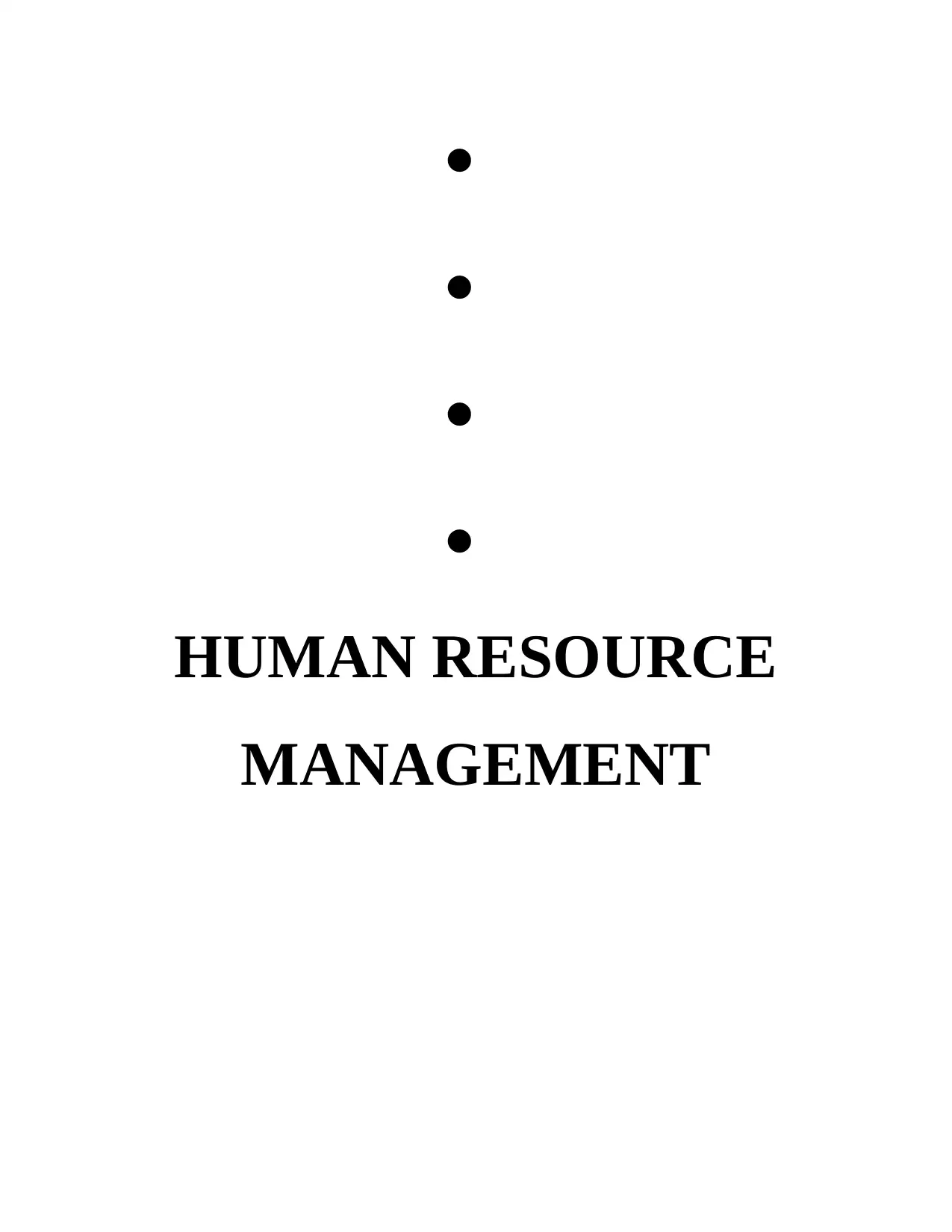
HUMAN RESOURCE
MANAGEMENT
HUMAN RESOURCE
MANAGEMENT
Paraphrase This Document
Need a fresh take? Get an instant paraphrase of this document with our AI Paraphraser
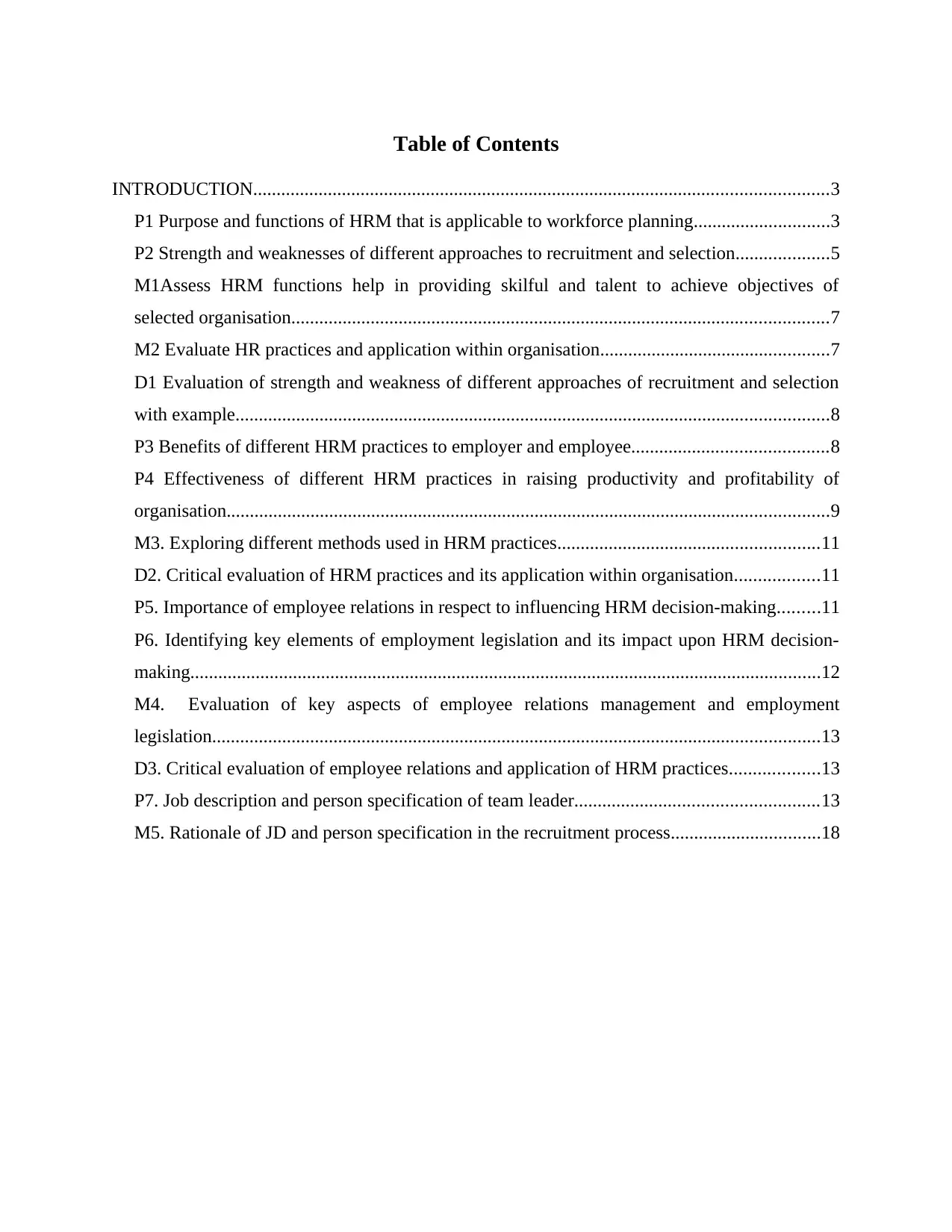
Table of Contents
INTRODUCTION...........................................................................................................................3
P1 Purpose and functions of HRM that is applicable to workforce planning.............................3
P2 Strength and weaknesses of different approaches to recruitment and selection....................5
M1Assess HRM functions help in providing skilful and talent to achieve objectives of
selected organisation...................................................................................................................7
M2 Evaluate HR practices and application within organisation.................................................7
D1 Evaluation of strength and weakness of different approaches of recruitment and selection
with example...............................................................................................................................8
P3 Benefits of different HRM practices to employer and employee..........................................8
P4 Effectiveness of different HRM practices in raising productivity and profitability of
organisation.................................................................................................................................9
M3. Exploring different methods used in HRM practices........................................................11
D2. Critical evaluation of HRM practices and its application within organisation..................11
P5. Importance of employee relations in respect to influencing HRM decision-making.........11
P6. Identifying key elements of employment legislation and its impact upon HRM decision-
making.......................................................................................................................................12
M4. Evaluation of key aspects of employee relations management and employment
legislation..................................................................................................................................13
D3. Critical evaluation of employee relations and application of HRM practices...................13
P7. Job description and person specification of team leader....................................................13
M5. Rationale of JD and person specification in the recruitment process................................18
INTRODUCTION...........................................................................................................................3
P1 Purpose and functions of HRM that is applicable to workforce planning.............................3
P2 Strength and weaknesses of different approaches to recruitment and selection....................5
M1Assess HRM functions help in providing skilful and talent to achieve objectives of
selected organisation...................................................................................................................7
M2 Evaluate HR practices and application within organisation.................................................7
D1 Evaluation of strength and weakness of different approaches of recruitment and selection
with example...............................................................................................................................8
P3 Benefits of different HRM practices to employer and employee..........................................8
P4 Effectiveness of different HRM practices in raising productivity and profitability of
organisation.................................................................................................................................9
M3. Exploring different methods used in HRM practices........................................................11
D2. Critical evaluation of HRM practices and its application within organisation..................11
P5. Importance of employee relations in respect to influencing HRM decision-making.........11
P6. Identifying key elements of employment legislation and its impact upon HRM decision-
making.......................................................................................................................................12
M4. Evaluation of key aspects of employee relations management and employment
legislation..................................................................................................................................13
D3. Critical evaluation of employee relations and application of HRM practices...................13
P7. Job description and person specification of team leader....................................................13
M5. Rationale of JD and person specification in the recruitment process................................18
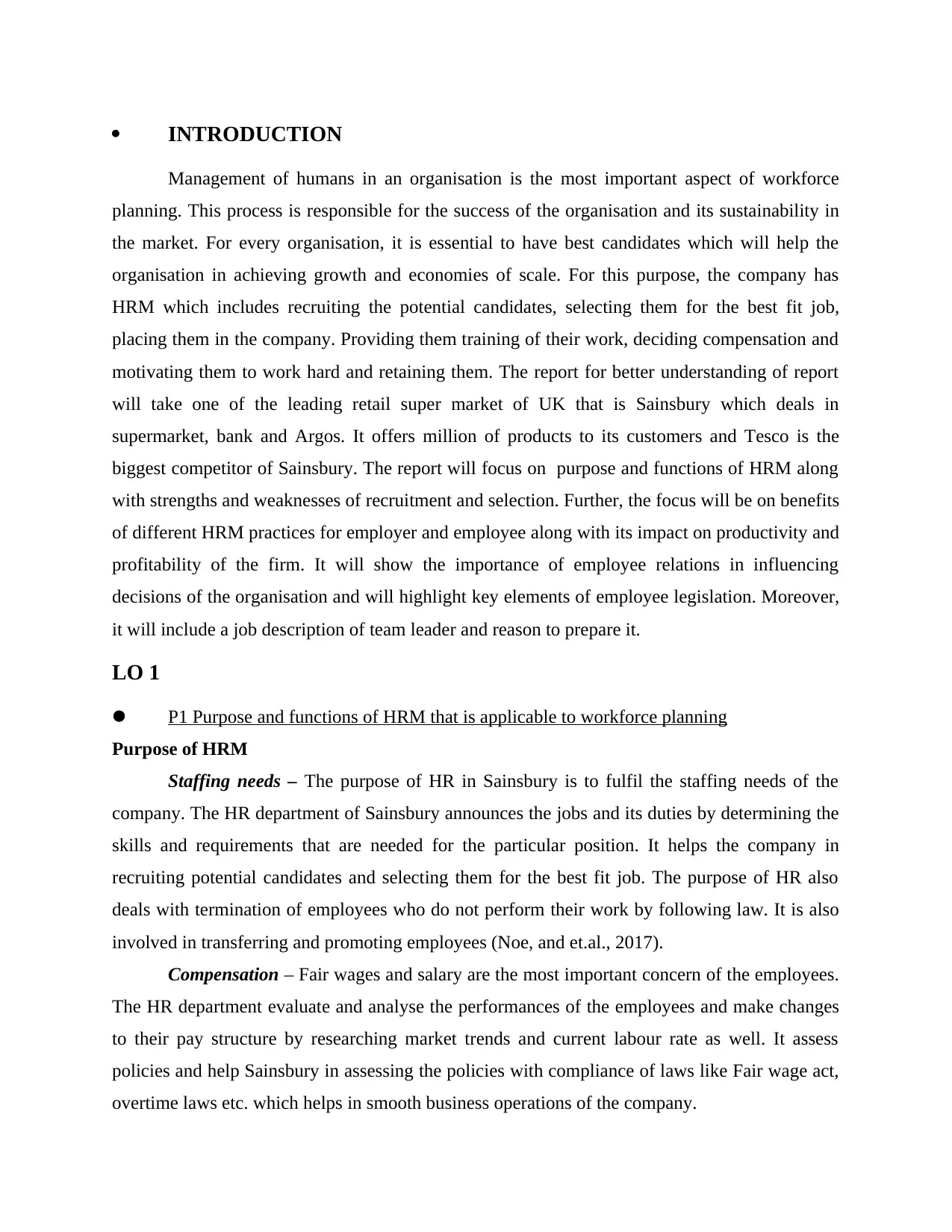
INTRODUCTION
Management of humans in an organisation is the most important aspect of workforce
planning. This process is responsible for the success of the organisation and its sustainability in
the market. For every organisation, it is essential to have best candidates which will help the
organisation in achieving growth and economies of scale. For this purpose, the company has
HRM which includes recruiting the potential candidates, selecting them for the best fit job,
placing them in the company. Providing them training of their work, deciding compensation and
motivating them to work hard and retaining them. The report for better understanding of report
will take one of the leading retail super market of UK that is Sainsbury which deals in
supermarket, bank and Argos. It offers million of products to its customers and Tesco is the
biggest competitor of Sainsbury. The report will focus on purpose and functions of HRM along
with strengths and weaknesses of recruitment and selection. Further, the focus will be on benefits
of different HRM practices for employer and employee along with its impact on productivity and
profitability of the firm. It will show the importance of employee relations in influencing
decisions of the organisation and will highlight key elements of employee legislation. Moreover,
it will include a job description of team leader and reason to prepare it.
LO 1
l P1 Purpose and functions of HRM that is applicable to workforce planning
Purpose of HRM
Staffing needs – The purpose of HR in Sainsbury is to fulfil the staffing needs of the
company. The HR department of Sainsbury announces the jobs and its duties by determining the
skills and requirements that are needed for the particular position. It helps the company in
recruiting potential candidates and selecting them for the best fit job. The purpose of HR also
deals with termination of employees who do not perform their work by following law. It is also
involved in transferring and promoting employees (Noe, and et.al., 2017).
Compensation – Fair wages and salary are the most important concern of the employees.
The HR department evaluate and analyse the performances of the employees and make changes
to their pay structure by researching market trends and current labour rate as well. It assess
policies and help Sainsbury in assessing the policies with compliance of laws like Fair wage act,
overtime laws etc. which helps in smooth business operations of the company.
Management of humans in an organisation is the most important aspect of workforce
planning. This process is responsible for the success of the organisation and its sustainability in
the market. For every organisation, it is essential to have best candidates which will help the
organisation in achieving growth and economies of scale. For this purpose, the company has
HRM which includes recruiting the potential candidates, selecting them for the best fit job,
placing them in the company. Providing them training of their work, deciding compensation and
motivating them to work hard and retaining them. The report for better understanding of report
will take one of the leading retail super market of UK that is Sainsbury which deals in
supermarket, bank and Argos. It offers million of products to its customers and Tesco is the
biggest competitor of Sainsbury. The report will focus on purpose and functions of HRM along
with strengths and weaknesses of recruitment and selection. Further, the focus will be on benefits
of different HRM practices for employer and employee along with its impact on productivity and
profitability of the firm. It will show the importance of employee relations in influencing
decisions of the organisation and will highlight key elements of employee legislation. Moreover,
it will include a job description of team leader and reason to prepare it.
LO 1
l P1 Purpose and functions of HRM that is applicable to workforce planning
Purpose of HRM
Staffing needs – The purpose of HR in Sainsbury is to fulfil the staffing needs of the
company. The HR department of Sainsbury announces the jobs and its duties by determining the
skills and requirements that are needed for the particular position. It helps the company in
recruiting potential candidates and selecting them for the best fit job. The purpose of HR also
deals with termination of employees who do not perform their work by following law. It is also
involved in transferring and promoting employees (Noe, and et.al., 2017).
Compensation – Fair wages and salary are the most important concern of the employees.
The HR department evaluate and analyse the performances of the employees and make changes
to their pay structure by researching market trends and current labour rate as well. It assess
policies and help Sainsbury in assessing the policies with compliance of laws like Fair wage act,
overtime laws etc. which helps in smooth business operations of the company.
⊘ This is a preview!⊘
Do you want full access?
Subscribe today to unlock all pages.

Trusted by 1+ million students worldwide
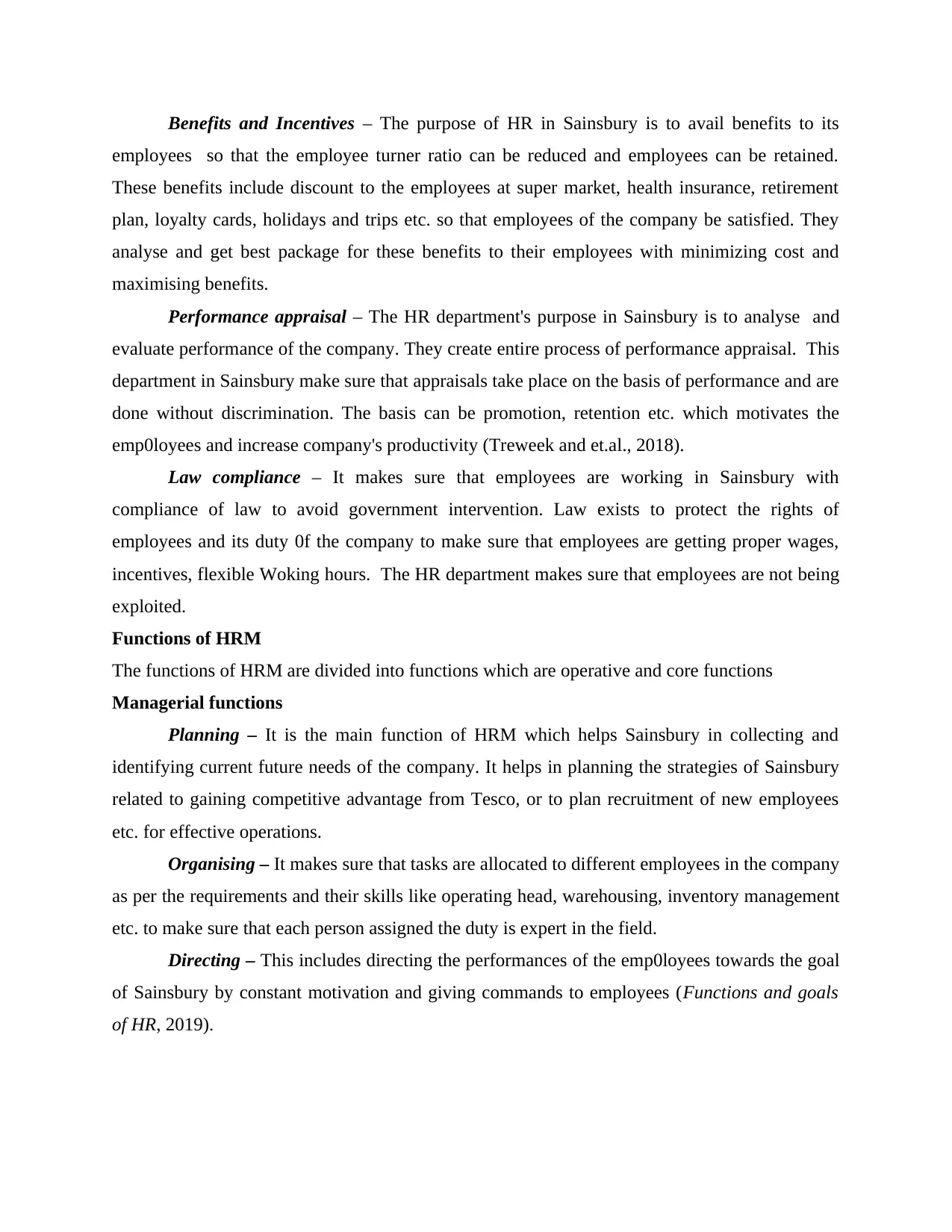
Benefits and Incentives – The purpose of HR in Sainsbury is to avail benefits to its
employees so that the employee turner ratio can be reduced and employees can be retained.
These benefits include discount to the employees at super market, health insurance, retirement
plan, loyalty cards, holidays and trips etc. so that employees of the company be satisfied. They
analyse and get best package for these benefits to their employees with minimizing cost and
maximising benefits.
Performance appraisal – The HR department's purpose in Sainsbury is to analyse and
evaluate performance of the company. They create entire process of performance appraisal. This
department in Sainsbury make sure that appraisals take place on the basis of performance and are
done without discrimination. The basis can be promotion, retention etc. which motivates the
emp0loyees and increase company's productivity (Treweek and et.al., 2018).
Law compliance – It makes sure that employees are working in Sainsbury with
compliance of law to avoid government intervention. Law exists to protect the rights of
employees and its duty 0f the company to make sure that employees are getting proper wages,
incentives, flexible Woking hours. The HR department makes sure that employees are not being
exploited.
Functions of HRM
The functions of HRM are divided into functions which are operative and core functions
Managerial functions
Planning – It is the main function of HRM which helps Sainsbury in collecting and
identifying current future needs of the company. It helps in planning the strategies of Sainsbury
related to gaining competitive advantage from Tesco, or to plan recruitment of new employees
etc. for effective operations.
Organising – It makes sure that tasks are allocated to different employees in the company
as per the requirements and their skills like operating head, warehousing, inventory management
etc. to make sure that each person assigned the duty is expert in the field.
Directing – This includes directing the performances of the emp0loyees towards the goal
of Sainsbury by constant motivation and giving commands to employees (Functions and goals
of HR, 2019).
employees so that the employee turner ratio can be reduced and employees can be retained.
These benefits include discount to the employees at super market, health insurance, retirement
plan, loyalty cards, holidays and trips etc. so that employees of the company be satisfied. They
analyse and get best package for these benefits to their employees with minimizing cost and
maximising benefits.
Performance appraisal – The HR department's purpose in Sainsbury is to analyse and
evaluate performance of the company. They create entire process of performance appraisal. This
department in Sainsbury make sure that appraisals take place on the basis of performance and are
done without discrimination. The basis can be promotion, retention etc. which motivates the
emp0loyees and increase company's productivity (Treweek and et.al., 2018).
Law compliance – It makes sure that employees are working in Sainsbury with
compliance of law to avoid government intervention. Law exists to protect the rights of
employees and its duty 0f the company to make sure that employees are getting proper wages,
incentives, flexible Woking hours. The HR department makes sure that employees are not being
exploited.
Functions of HRM
The functions of HRM are divided into functions which are operative and core functions
Managerial functions
Planning – It is the main function of HRM which helps Sainsbury in collecting and
identifying current future needs of the company. It helps in planning the strategies of Sainsbury
related to gaining competitive advantage from Tesco, or to plan recruitment of new employees
etc. for effective operations.
Organising – It makes sure that tasks are allocated to different employees in the company
as per the requirements and their skills like operating head, warehousing, inventory management
etc. to make sure that each person assigned the duty is expert in the field.
Directing – This includes directing the performances of the emp0loyees towards the goal
of Sainsbury by constant motivation and giving commands to employees (Functions and goals
of HR, 2019).
Paraphrase This Document
Need a fresh take? Get an instant paraphrase of this document with our AI Paraphraser
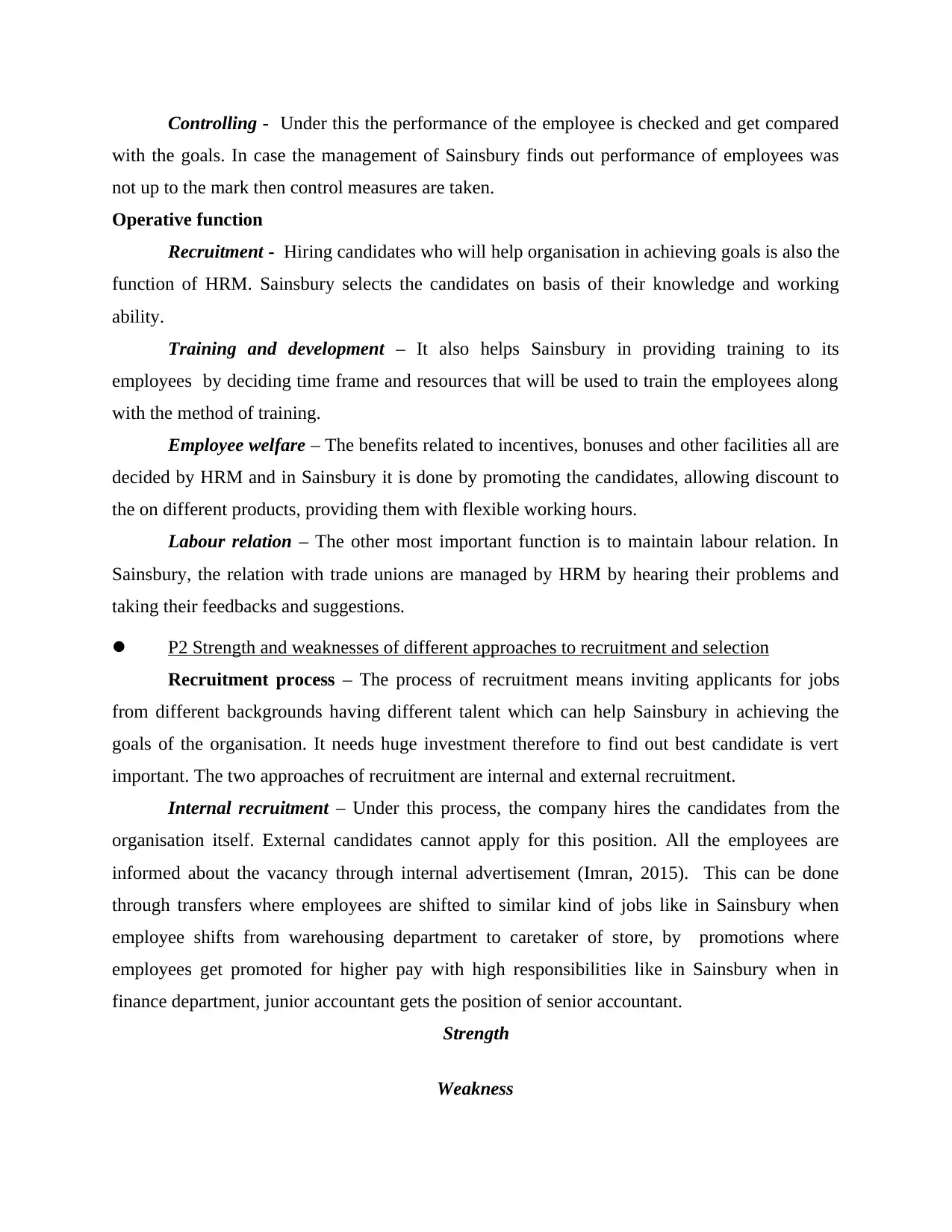
Controlling - Under this the performance of the employee is checked and get compared
with the goals. In case the management of Sainsbury finds out performance of employees was
not up to the mark then control measures are taken.
Operative function
Recruitment - Hiring candidates who will help organisation in achieving goals is also the
function of HRM. Sainsbury selects the candidates on basis of their knowledge and working
ability.
Training and development – It also helps Sainsbury in providing training to its
employees by deciding time frame and resources that will be used to train the employees along
with the method of training.
Employee welfare – The benefits related to incentives, bonuses and other facilities all are
decided by HRM and in Sainsbury it is done by promoting the candidates, allowing discount to
the on different products, providing them with flexible working hours.
Labour relation – The other most important function is to maintain labour relation. In
Sainsbury, the relation with trade unions are managed by HRM by hearing their problems and
taking their feedbacks and suggestions.
l P2 Strength and weaknesses of different approaches to recruitment and selection
Recruitment process – The process of recruitment means inviting applicants for jobs
from different backgrounds having different talent which can help Sainsbury in achieving the
goals of the organisation. It needs huge investment therefore to find out best candidate is vert
important. The two approaches of recruitment are internal and external recruitment.
Internal recruitment – Under this process, the company hires the candidates from the
organisation itself. External candidates cannot apply for this position. All the employees are
informed about the vacancy through internal advertisement (Imran, 2015). This can be done
through transfers where employees are shifted to similar kind of jobs like in Sainsbury when
employee shifts from warehousing department to caretaker of store, by promotions where
employees get promoted for higher pay with high responsibilities like in Sainsbury when in
finance department, junior accountant gets the position of senior accountant.
Strength
Weakness
with the goals. In case the management of Sainsbury finds out performance of employees was
not up to the mark then control measures are taken.
Operative function
Recruitment - Hiring candidates who will help organisation in achieving goals is also the
function of HRM. Sainsbury selects the candidates on basis of their knowledge and working
ability.
Training and development – It also helps Sainsbury in providing training to its
employees by deciding time frame and resources that will be used to train the employees along
with the method of training.
Employee welfare – The benefits related to incentives, bonuses and other facilities all are
decided by HRM and in Sainsbury it is done by promoting the candidates, allowing discount to
the on different products, providing them with flexible working hours.
Labour relation – The other most important function is to maintain labour relation. In
Sainsbury, the relation with trade unions are managed by HRM by hearing their problems and
taking their feedbacks and suggestions.
l P2 Strength and weaknesses of different approaches to recruitment and selection
Recruitment process – The process of recruitment means inviting applicants for jobs
from different backgrounds having different talent which can help Sainsbury in achieving the
goals of the organisation. It needs huge investment therefore to find out best candidate is vert
important. The two approaches of recruitment are internal and external recruitment.
Internal recruitment – Under this process, the company hires the candidates from the
organisation itself. External candidates cannot apply for this position. All the employees are
informed about the vacancy through internal advertisement (Imran, 2015). This can be done
through transfers where employees are shifted to similar kind of jobs like in Sainsbury when
employee shifts from warehousing department to caretaker of store, by promotions where
employees get promoted for higher pay with high responsibilities like in Sainsbury when in
finance department, junior accountant gets the position of senior accountant.
Strength
Weakness
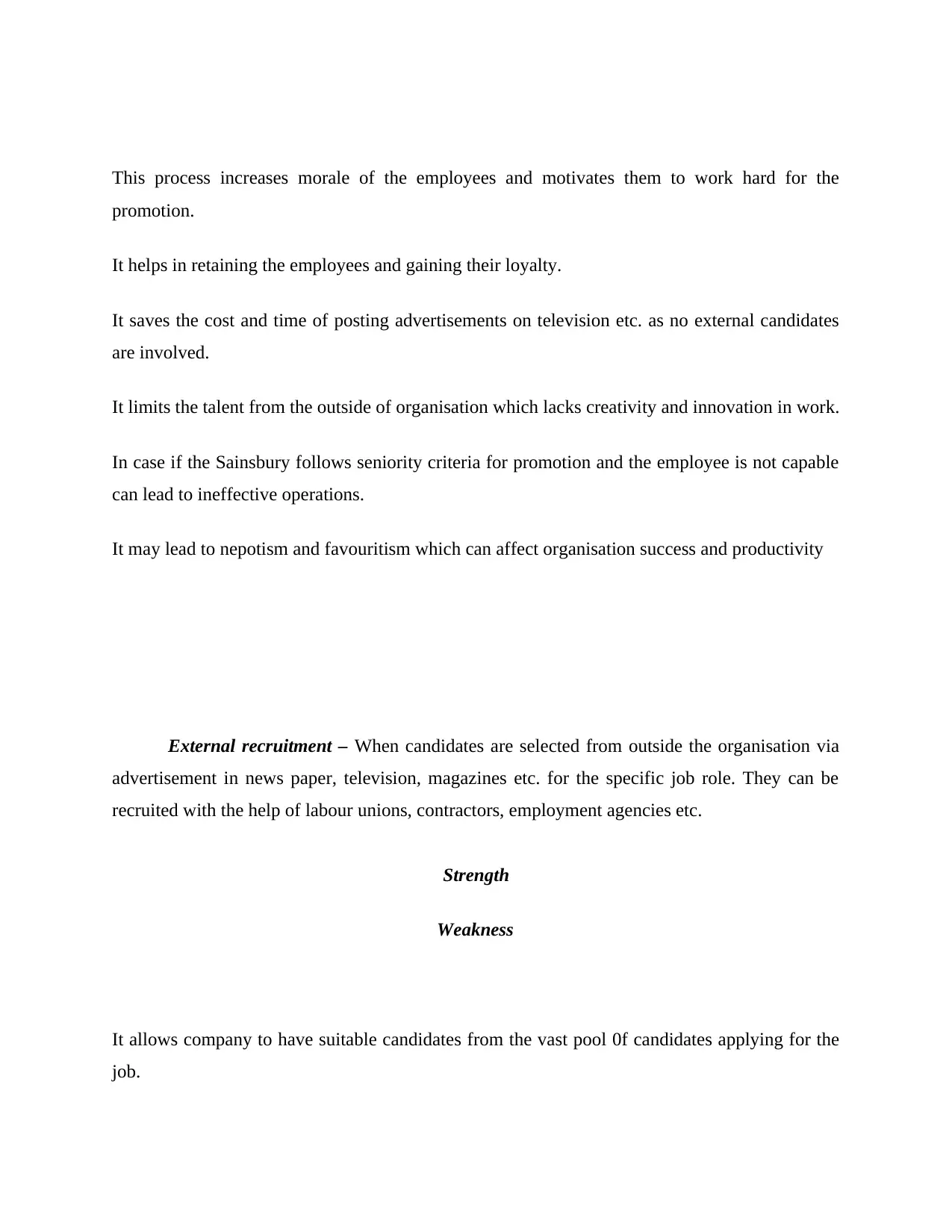
This process increases morale of the employees and motivates them to work hard for the
promotion.
It helps in retaining the employees and gaining their loyalty.
It saves the cost and time of posting advertisements on television etc. as no external candidates
are involved.
It limits the talent from the outside of organisation which lacks creativity and innovation in work.
In case if the Sainsbury follows seniority criteria for promotion and the employee is not capable
can lead to ineffective operations.
It may lead to nepotism and favouritism which can affect organisation success and productivity
External recruitment – When candidates are selected from outside the organisation via
advertisement in news paper, television, magazines etc. for the specific job role. They can be
recruited with the help of labour unions, contractors, employment agencies etc.
Strength
Weakness
It allows company to have suitable candidates from the vast pool 0f candidates applying for the
job.
promotion.
It helps in retaining the employees and gaining their loyalty.
It saves the cost and time of posting advertisements on television etc. as no external candidates
are involved.
It limits the talent from the outside of organisation which lacks creativity and innovation in work.
In case if the Sainsbury follows seniority criteria for promotion and the employee is not capable
can lead to ineffective operations.
It may lead to nepotism and favouritism which can affect organisation success and productivity
External recruitment – When candidates are selected from outside the organisation via
advertisement in news paper, television, magazines etc. for the specific job role. They can be
recruited with the help of labour unions, contractors, employment agencies etc.
Strength
Weakness
It allows company to have suitable candidates from the vast pool 0f candidates applying for the
job.
⊘ This is a preview!⊘
Do you want full access?
Subscribe today to unlock all pages.

Trusted by 1+ million students worldwide
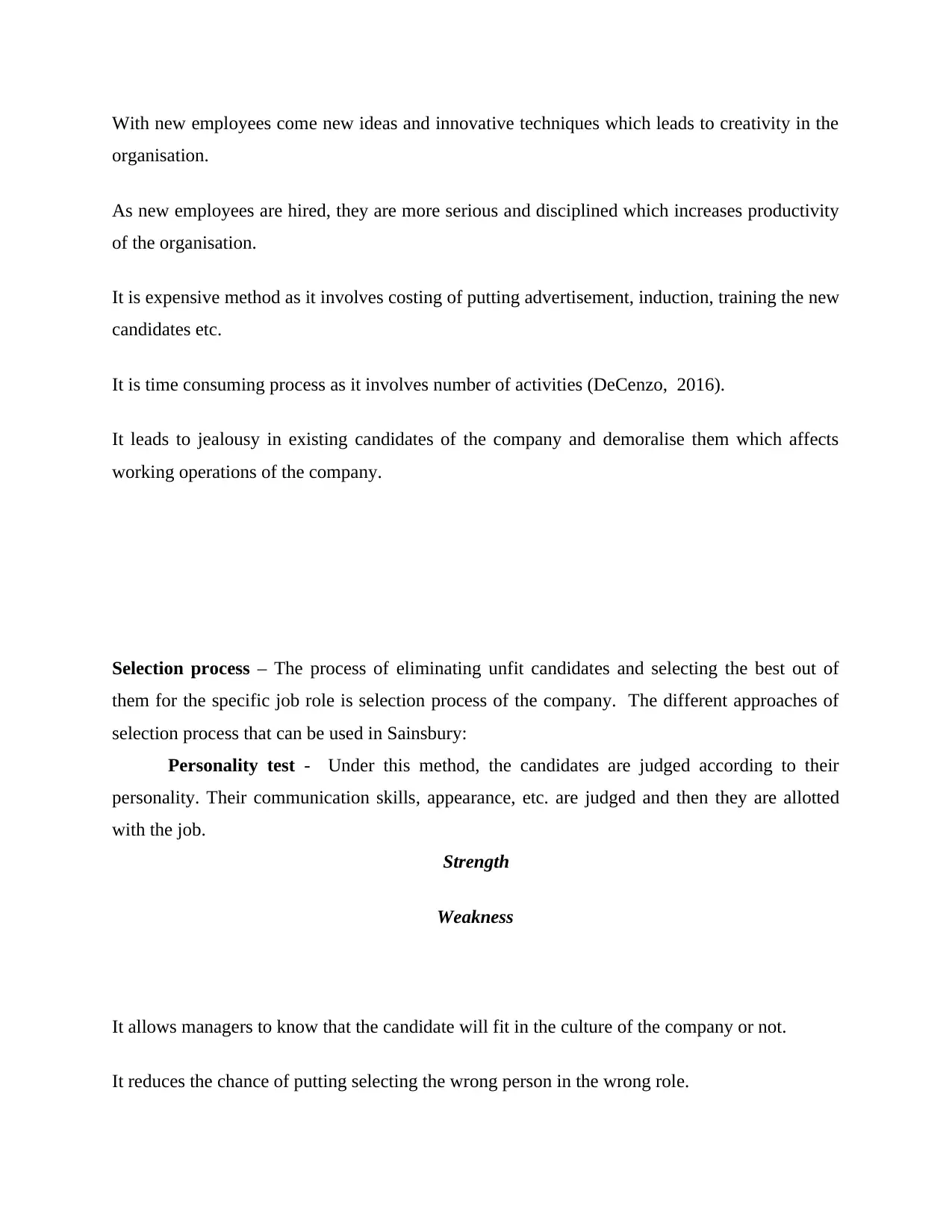
With new employees come new ideas and innovative techniques which leads to creativity in the
organisation.
As new employees are hired, they are more serious and disciplined which increases productivity
of the organisation.
It is expensive method as it involves costing of putting advertisement, induction, training the new
candidates etc.
It is time consuming process as it involves number of activities (DeCenzo, 2016).
It leads to jealousy in existing candidates of the company and demoralise them which affects
working operations of the company.
Selection process – The process of eliminating unfit candidates and selecting the best out of
them for the specific job role is selection process of the company. The different approaches of
selection process that can be used in Sainsbury:
Personality test - Under this method, the candidates are judged according to their
personality. Their communication skills, appearance, etc. are judged and then they are allotted
with the job.
Strength
Weakness
It allows managers to know that the candidate will fit in the culture of the company or not.
It reduces the chance of putting selecting the wrong person in the wrong role.
organisation.
As new employees are hired, they are more serious and disciplined which increases productivity
of the organisation.
It is expensive method as it involves costing of putting advertisement, induction, training the new
candidates etc.
It is time consuming process as it involves number of activities (DeCenzo, 2016).
It leads to jealousy in existing candidates of the company and demoralise them which affects
working operations of the company.
Selection process – The process of eliminating unfit candidates and selecting the best out of
them for the specific job role is selection process of the company. The different approaches of
selection process that can be used in Sainsbury:
Personality test - Under this method, the candidates are judged according to their
personality. Their communication skills, appearance, etc. are judged and then they are allotted
with the job.
Strength
Weakness
It allows managers to know that the candidate will fit in the culture of the company or not.
It reduces the chance of putting selecting the wrong person in the wrong role.
Paraphrase This Document
Need a fresh take? Get an instant paraphrase of this document with our AI Paraphraser
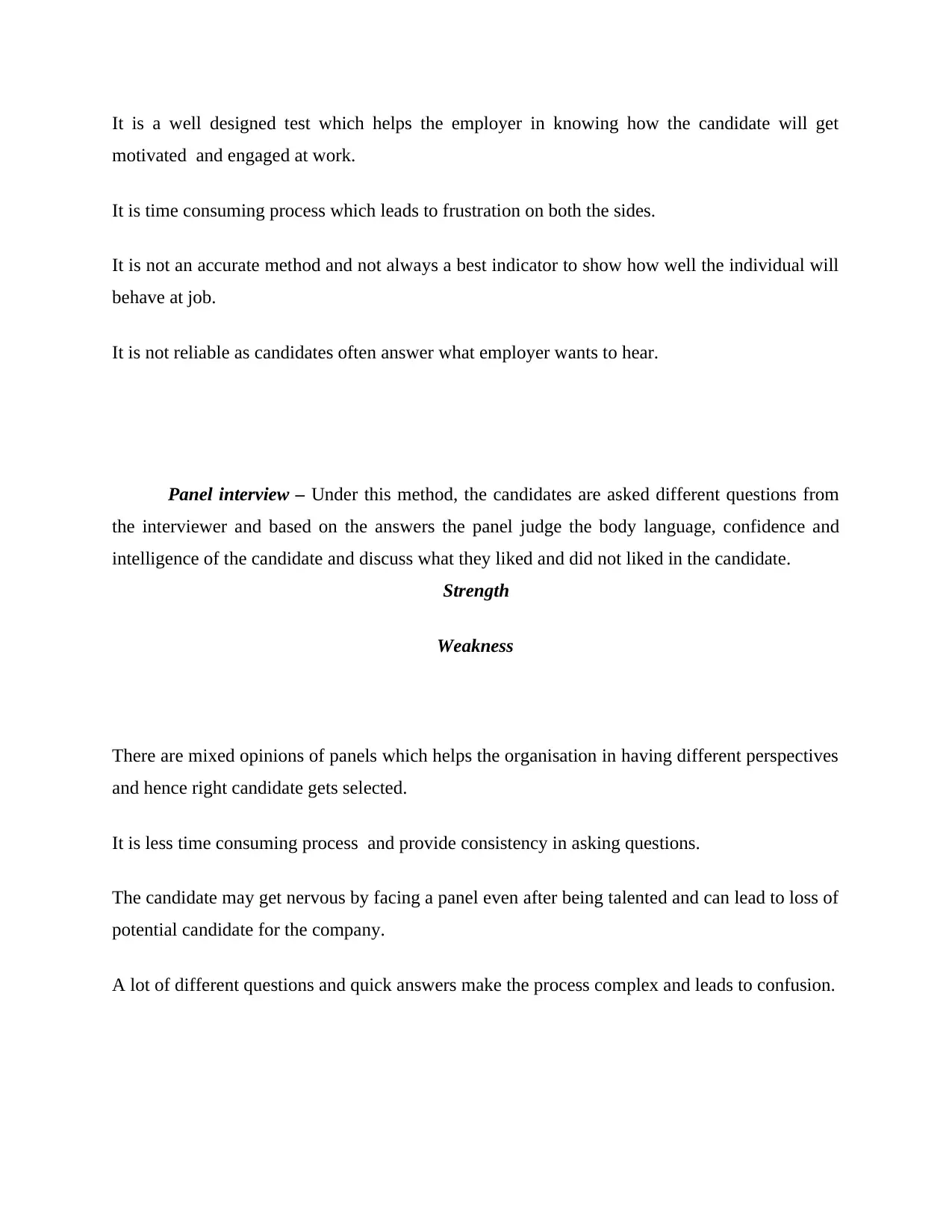
It is a well designed test which helps the employer in knowing how the candidate will get
motivated and engaged at work.
It is time consuming process which leads to frustration on both the sides.
It is not an accurate method and not always a best indicator to show how well the individual will
behave at job.
It is not reliable as candidates often answer what employer wants to hear.
Panel interview – Under this method, the candidates are asked different questions from
the interviewer and based on the answers the panel judge the body language, confidence and
intelligence of the candidate and discuss what they liked and did not liked in the candidate.
Strength
Weakness
There are mixed opinions of panels which helps the organisation in having different perspectives
and hence right candidate gets selected.
It is less time consuming process and provide consistency in asking questions.
The candidate may get nervous by facing a panel even after being talented and can lead to loss of
potential candidate for the company.
A lot of different questions and quick answers make the process complex and leads to confusion.
motivated and engaged at work.
It is time consuming process which leads to frustration on both the sides.
It is not an accurate method and not always a best indicator to show how well the individual will
behave at job.
It is not reliable as candidates often answer what employer wants to hear.
Panel interview – Under this method, the candidates are asked different questions from
the interviewer and based on the answers the panel judge the body language, confidence and
intelligence of the candidate and discuss what they liked and did not liked in the candidate.
Strength
Weakness
There are mixed opinions of panels which helps the organisation in having different perspectives
and hence right candidate gets selected.
It is less time consuming process and provide consistency in asking questions.
The candidate may get nervous by facing a panel even after being talented and can lead to loss of
potential candidate for the company.
A lot of different questions and quick answers make the process complex and leads to confusion.
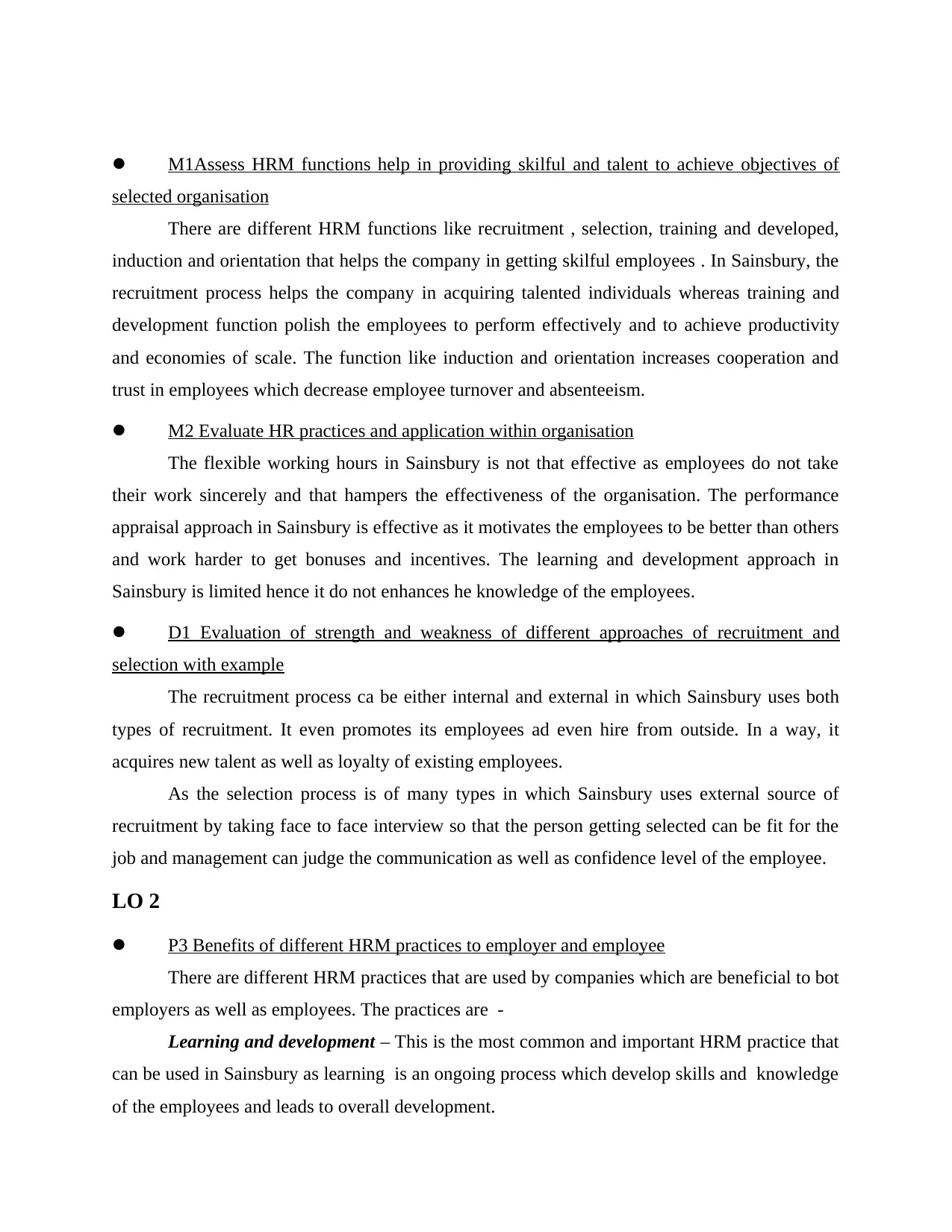
l M1Assess HRM functions help in providing skilful and talent to achieve objectives of
selected organisation
There are different HRM functions like recruitment , selection, training and developed,
induction and orientation that helps the company in getting skilful employees . In Sainsbury, the
recruitment process helps the company in acquiring talented individuals whereas training and
development function polish the employees to perform effectively and to achieve productivity
and economies of scale. The function like induction and orientation increases cooperation and
trust in employees which decrease employee turnover and absenteeism.
l M2 Evaluate HR practices and application within organisation
The flexible working hours in Sainsbury is not that effective as employees do not take
their work sincerely and that hampers the effectiveness of the organisation. The performance
appraisal approach in Sainsbury is effective as it motivates the employees to be better than others
and work harder to get bonuses and incentives. The learning and development approach in
Sainsbury is limited hence it do not enhances he knowledge of the employees.
l D1 Evaluation of strength and weakness of different approaches of recruitment and
selection with example
The recruitment process ca be either internal and external in which Sainsbury uses both
types of recruitment. It even promotes its employees ad even hire from outside. In a way, it
acquires new talent as well as loyalty of existing employees.
As the selection process is of many types in which Sainsbury uses external source of
recruitment by taking face to face interview so that the person getting selected can be fit for the
job and management can judge the communication as well as confidence level of the employee.
LO 2
l P3 Benefits of different HRM practices to employer and employee
There are different HRM practices that are used by companies which are beneficial to bot
employers as well as employees. The practices are -
Learning and development – This is the most common and important HRM practice that
can be used in Sainsbury as learning is an ongoing process which develop skills and knowledge
of the employees and leads to overall development.
selected organisation
There are different HRM functions like recruitment , selection, training and developed,
induction and orientation that helps the company in getting skilful employees . In Sainsbury, the
recruitment process helps the company in acquiring talented individuals whereas training and
development function polish the employees to perform effectively and to achieve productivity
and economies of scale. The function like induction and orientation increases cooperation and
trust in employees which decrease employee turnover and absenteeism.
l M2 Evaluate HR practices and application within organisation
The flexible working hours in Sainsbury is not that effective as employees do not take
their work sincerely and that hampers the effectiveness of the organisation. The performance
appraisal approach in Sainsbury is effective as it motivates the employees to be better than others
and work harder to get bonuses and incentives. The learning and development approach in
Sainsbury is limited hence it do not enhances he knowledge of the employees.
l D1 Evaluation of strength and weakness of different approaches of recruitment and
selection with example
The recruitment process ca be either internal and external in which Sainsbury uses both
types of recruitment. It even promotes its employees ad even hire from outside. In a way, it
acquires new talent as well as loyalty of existing employees.
As the selection process is of many types in which Sainsbury uses external source of
recruitment by taking face to face interview so that the person getting selected can be fit for the
job and management can judge the communication as well as confidence level of the employee.
LO 2
l P3 Benefits of different HRM practices to employer and employee
There are different HRM practices that are used by companies which are beneficial to bot
employers as well as employees. The practices are -
Learning and development – This is the most common and important HRM practice that
can be used in Sainsbury as learning is an ongoing process which develop skills and knowledge
of the employees and leads to overall development.
⊘ This is a preview!⊘
Do you want full access?
Subscribe today to unlock all pages.

Trusted by 1+ million students worldwide
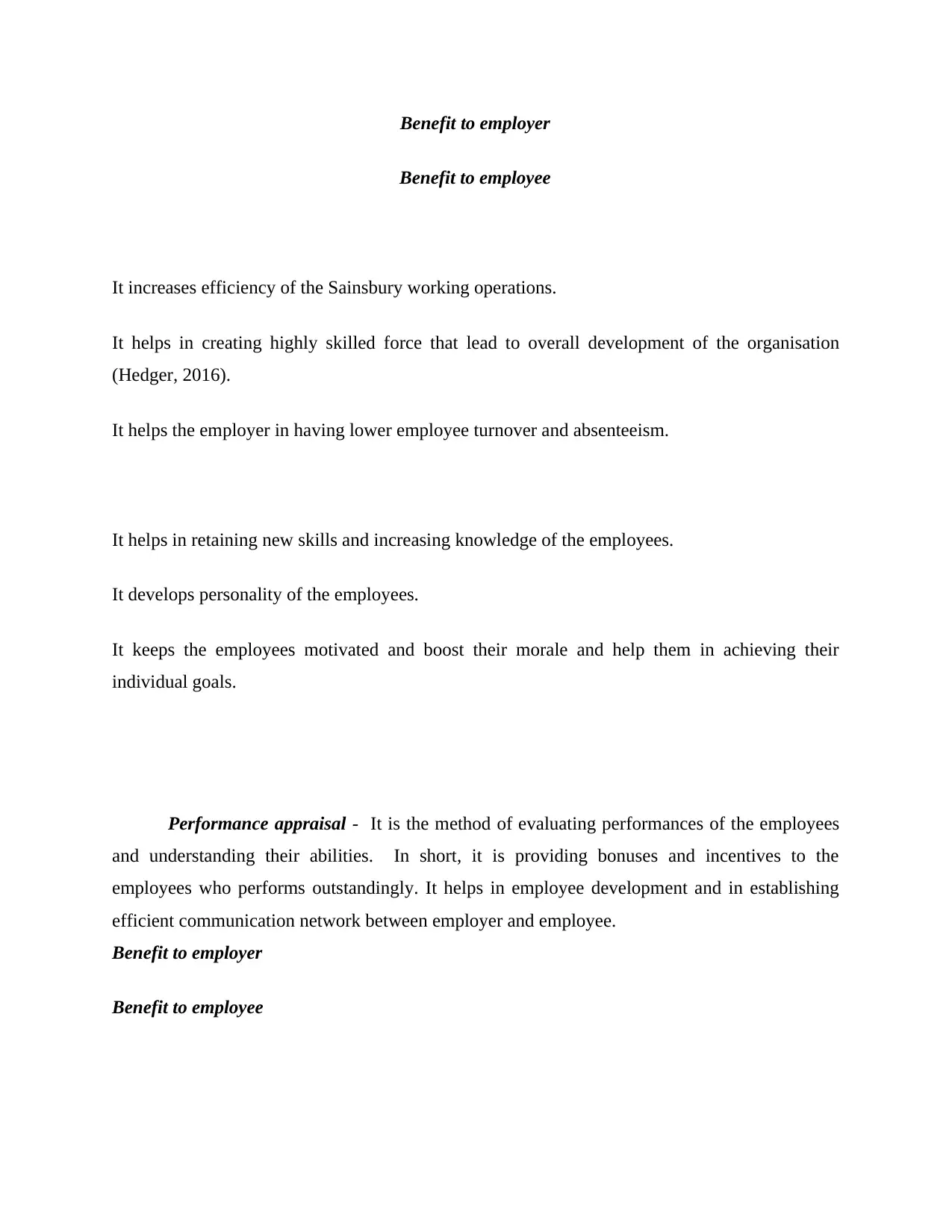
Benefit to employer
Benefit to employee
It increases efficiency of the Sainsbury working operations.
It helps in creating highly skilled force that lead to overall development of the organisation
(Hedger, 2016).
It helps the employer in having lower employee turnover and absenteeism.
It helps in retaining new skills and increasing knowledge of the employees.
It develops personality of the employees.
It keeps the employees motivated and boost their morale and help them in achieving their
individual goals.
Performance appraisal - It is the method of evaluating performances of the employees
and understanding their abilities. In short, it is providing bonuses and incentives to the
employees who performs outstandingly. It helps in employee development and in establishing
efficient communication network between employer and employee.
Benefit to employer
Benefit to employee
Benefit to employee
It increases efficiency of the Sainsbury working operations.
It helps in creating highly skilled force that lead to overall development of the organisation
(Hedger, 2016).
It helps the employer in having lower employee turnover and absenteeism.
It helps in retaining new skills and increasing knowledge of the employees.
It develops personality of the employees.
It keeps the employees motivated and boost their morale and help them in achieving their
individual goals.
Performance appraisal - It is the method of evaluating performances of the employees
and understanding their abilities. In short, it is providing bonuses and incentives to the
employees who performs outstandingly. It helps in employee development and in establishing
efficient communication network between employer and employee.
Benefit to employer
Benefit to employee
Paraphrase This Document
Need a fresh take? Get an instant paraphrase of this document with our AI Paraphraser
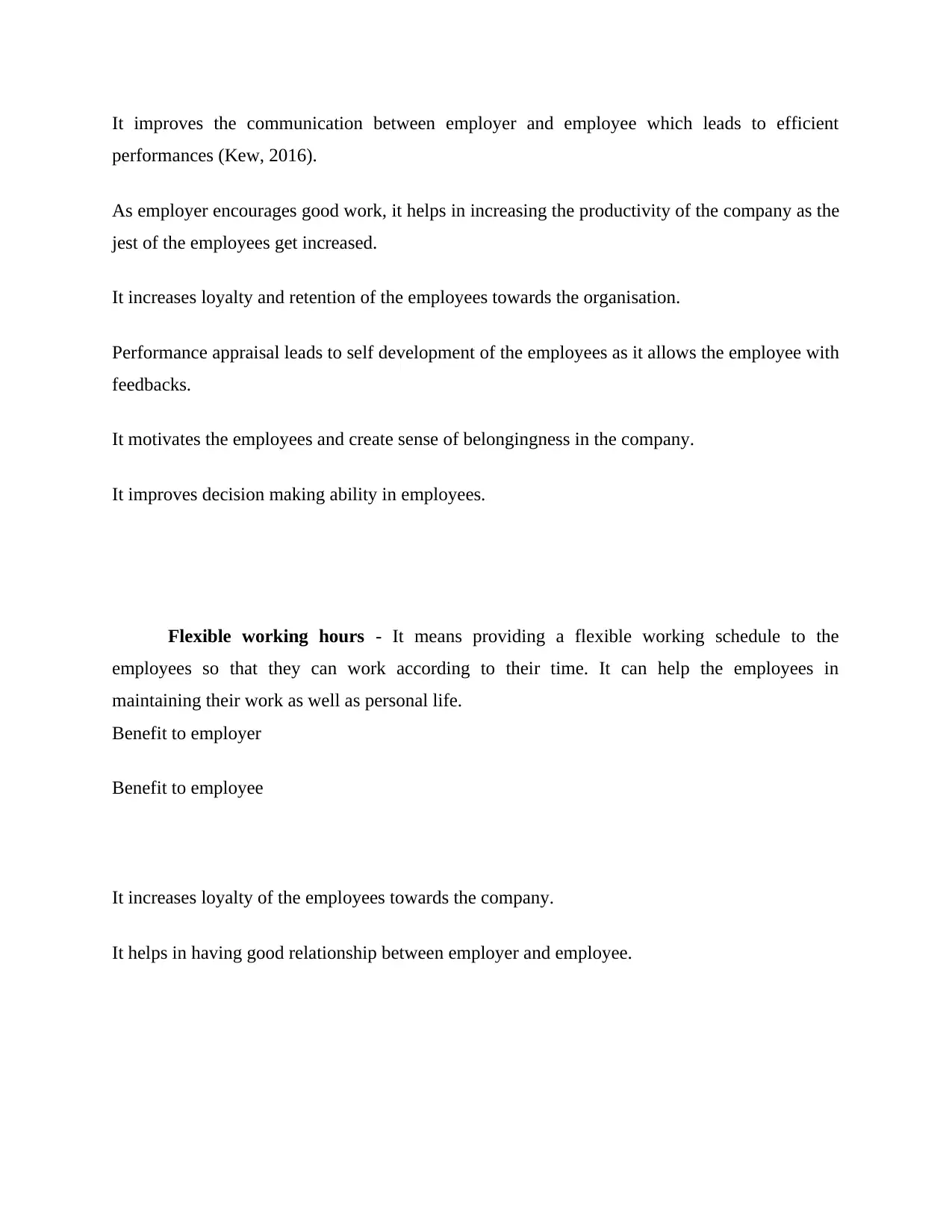
It improves the communication between employer and employee which leads to efficient
performances (Kew, 2016).
As employer encourages good work, it helps in increasing the productivity of the company as the
jest of the employees get increased.
It increases loyalty and retention of the employees towards the organisation.
Performance appraisal leads to self development of the employees as it allows the employee with
feedbacks.
It motivates the employees and create sense of belongingness in the company.
It improves decision making ability in employees.
Flexible working hours - It means providing a flexible working schedule to the
employees so that they can work according to their time. It can help the employees in
maintaining their work as well as personal life.
Benefit to employer
Benefit to employee
It increases loyalty of the employees towards the company.
It helps in having good relationship between employer and employee.
performances (Kew, 2016).
As employer encourages good work, it helps in increasing the productivity of the company as the
jest of the employees get increased.
It increases loyalty and retention of the employees towards the organisation.
Performance appraisal leads to self development of the employees as it allows the employee with
feedbacks.
It motivates the employees and create sense of belongingness in the company.
It improves decision making ability in employees.
Flexible working hours - It means providing a flexible working schedule to the
employees so that they can work according to their time. It can help the employees in
maintaining their work as well as personal life.
Benefit to employer
Benefit to employee
It increases loyalty of the employees towards the company.
It helps in having good relationship between employer and employee.
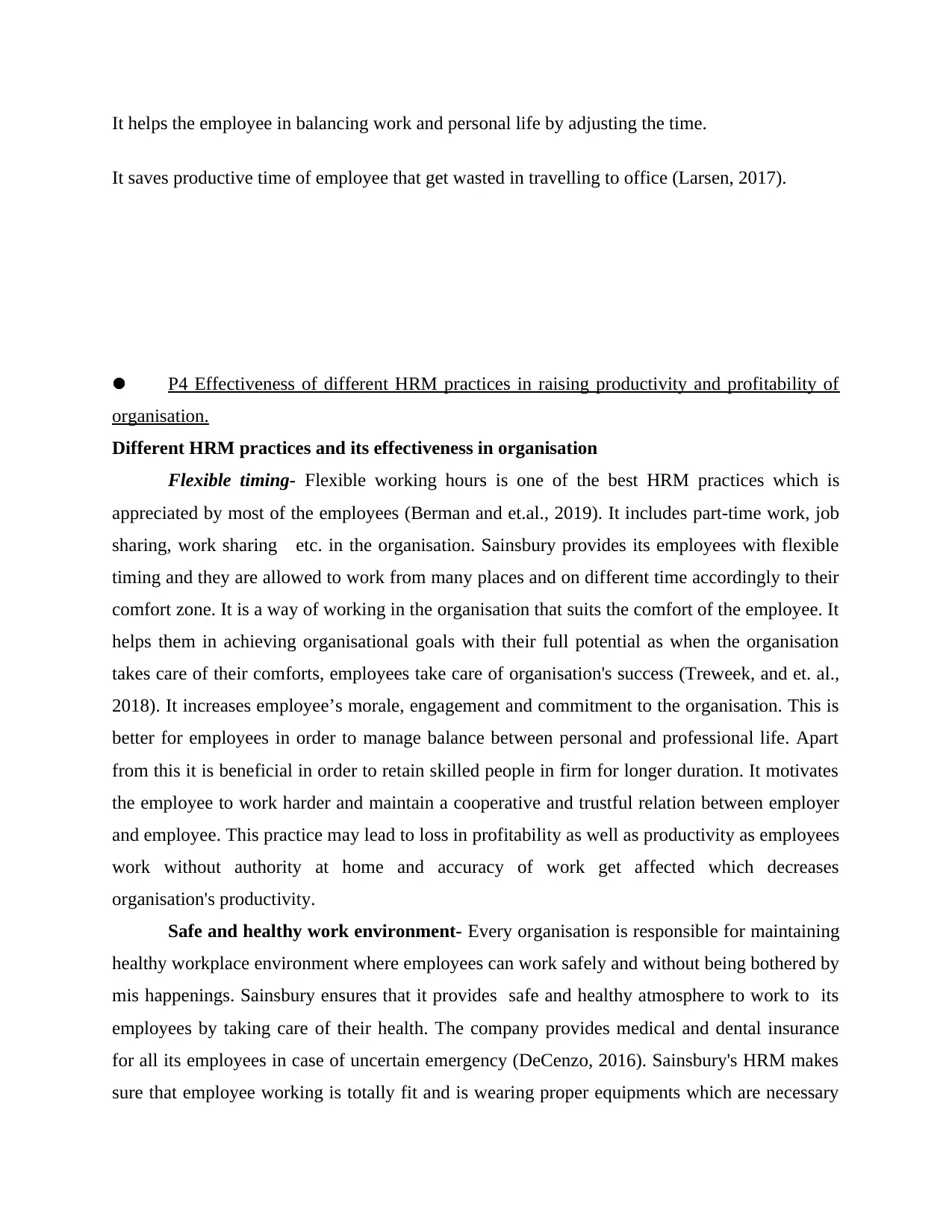
It helps the employee in balancing work and personal life by adjusting the time.
It saves productive time of employee that get wasted in travelling to office (Larsen, 2017).
l P4 Effectiveness of different HRM practices in raising productivity and profitability of
organisation.
Different HRM practices and its effectiveness in organisation
Flexible timing- Flexible working hours is one of the best HRM practices which is
appreciated by most of the employees (Berman and et.al., 2019). It includes part-time work, job
sharing, work sharing etc. in the organisation. Sainsbury provides its employees with flexible
timing and they are allowed to work from many places and on different time accordingly to their
comfort zone. It is a way of working in the organisation that suits the comfort of the employee. It
helps them in achieving organisational goals with their full potential as when the organisation
takes care of their comforts, employees take care of organisation's success (Treweek, and et. al.,
2018). It increases employee’s morale, engagement and commitment to the organisation. This is
better for employees in order to manage balance between personal and professional life. Apart
from this it is beneficial in order to retain skilled people in firm for longer duration. It motivates
the employee to work harder and maintain a cooperative and trustful relation between employer
and employee. This practice may lead to loss in profitability as well as productivity as employees
work without authority at home and accuracy of work get affected which decreases
organisation's productivity.
Safe and healthy work environment- Every organisation is responsible for maintaining
healthy workplace environment where employees can work safely and without being bothered by
mis happenings. Sainsbury ensures that it provides safe and healthy atmosphere to work to its
employees by taking care of their health. The company provides medical and dental insurance
for all its employees in case of uncertain emergency (DeCenzo, 2016). Sainsbury's HRM makes
sure that employee working is totally fit and is wearing proper equipments which are necessary
It saves productive time of employee that get wasted in travelling to office (Larsen, 2017).
l P4 Effectiveness of different HRM practices in raising productivity and profitability of
organisation.
Different HRM practices and its effectiveness in organisation
Flexible timing- Flexible working hours is one of the best HRM practices which is
appreciated by most of the employees (Berman and et.al., 2019). It includes part-time work, job
sharing, work sharing etc. in the organisation. Sainsbury provides its employees with flexible
timing and they are allowed to work from many places and on different time accordingly to their
comfort zone. It is a way of working in the organisation that suits the comfort of the employee. It
helps them in achieving organisational goals with their full potential as when the organisation
takes care of their comforts, employees take care of organisation's success (Treweek, and et. al.,
2018). It increases employee’s morale, engagement and commitment to the organisation. This is
better for employees in order to manage balance between personal and professional life. Apart
from this it is beneficial in order to retain skilled people in firm for longer duration. It motivates
the employee to work harder and maintain a cooperative and trustful relation between employer
and employee. This practice may lead to loss in profitability as well as productivity as employees
work without authority at home and accuracy of work get affected which decreases
organisation's productivity.
Safe and healthy work environment- Every organisation is responsible for maintaining
healthy workplace environment where employees can work safely and without being bothered by
mis happenings. Sainsbury ensures that it provides safe and healthy atmosphere to work to its
employees by taking care of their health. The company provides medical and dental insurance
for all its employees in case of uncertain emergency (DeCenzo, 2016). Sainsbury's HRM makes
sure that employee working is totally fit and is wearing proper equipments which are necessary
⊘ This is a preview!⊘
Do you want full access?
Subscribe today to unlock all pages.

Trusted by 1+ million students worldwide
1 out of 32
Related Documents
Your All-in-One AI-Powered Toolkit for Academic Success.
+13062052269
info@desklib.com
Available 24*7 on WhatsApp / Email
![[object Object]](/_next/static/media/star-bottom.7253800d.svg)
Unlock your academic potential
Copyright © 2020–2025 A2Z Services. All Rights Reserved. Developed and managed by ZUCOL.





